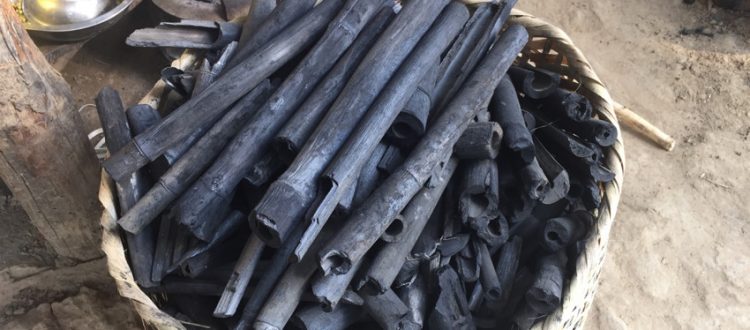GEI Insight|Research on Myanmar Bamboo Industry
GEI’s Bamboo Team is at it again! Since last year’s investigation and study trip to see Myanmar’s bamboo forest and meet with bamboo entrepreneurs, they have been busy at work researching the capacity of Myanmar’s bamboo industry. (Click here to read about last year’s work!)
During their recent business trip, the Team focused on gaining a 360-degree understanding of Myanmar’s bamboo business from industry policies to resources, processing and markets.
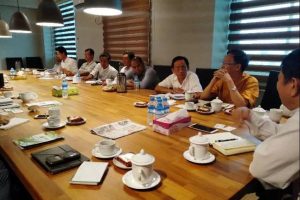
The Bamboo Investigation team discuss with the Myanmar Rattan and Bamboo Entrepreneurs Association
Photo Credit: GEI
Over the five-day trip, the GEI Team banded together with experts from outstanding Chinese and Japanese bamboo processing companies to meet with research departments, entrepreneurs association, processing companies, equipment suppliers, farmers and representatives from industrial parks, building material companies and furniture exhibitions.
It was a whirlwind trip and we learned a great deal. We also feel optimistic that bamboo is not only an exceedingly useful material but – if developed into a sustainable industry – it can also help reduce the demand for wood, and therefore decrease deforestation.
What We Learned about Myanmar’s Bamboo Resource
Myanmar is the 3rd largest bamboo resource country in the world and it has over 100 species of bamboo growing across three natural bamboo forests. Even though Myanmar’s bamboo processing capacity is relatively high, the industry has not developed in a sustainable way thus far.
Poorly managed harvesting and planting are already causing bamboo resources to sharply decline, and undercutting potential business models.
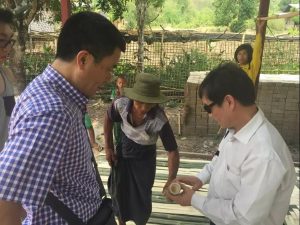
Bamboo farmers sharing information on local bamboo resources
Photo Credit: GEI
What We’ve Learned about Bamboo Processing
At the beginning of any industry, there is a period of growth and learning. Experts from the Chinese and Japanese bamboo companies pointed out that even though the Myanmar bamboo companies are experiencing certain problems, the sector’s improvements should not be overlooked.
In fact, they were impressed that the Myanmar companies are already producing a variety of products – including, handicrafts, chopsticks, skewers, charcoal and flooring.
Moving forward, the Myanmar bamboo companies have two areas for improvement:
1. Increasing company size – as right now, most ‘companies’ operate in small community workshops;
2. Modernizing processing equipment, techniques and standards.
If these two aspects can be consistently improved, we are confident that the industry can more efficiently utilize resources and reduce costs.
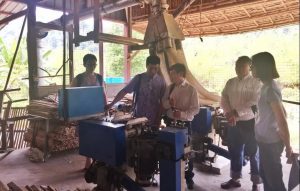
The team visits a bamboo processing plant.
Photo Credit:GEI
What We Learned about the Bamboo Market
Myanmar’s bamboo production and supply chains are relatively complete and products have begun to capture a niche, domestic market.
Based on surveys with companies, there is evidence that the market needs to grow both in terms of types of products available for sale and market scope. With increased training and investment, Myanmar companies should prioritize the production of more valuable products and expand to international markets.
What We Learned about Bamboo Industry Policy
The Myanmar government has increasingly focused on promoting the development of the bamboo industry in order to provide a strong alternative to wood resource consumption. In fact, over the past few decades, Myanmar has experienced extreme deforestation and reduction in forest resources – which was in part driven by early policies supporting timber and teak industries.
In addition to the Myanmar Government’s strong actions to crack down on illegal logging, we hope that supporting the bamboo industry will be a proactive step in Myanmar’s sustainable development. To this end, establishing a national-level bamboo industry strategy and implementing policies that benefit farmers and businessare critical next steps.
Recommendations for Myanmar’s Bamboo Industry Development
After reflecting on our trip, the Chinese and Japanese bamboo companies drafted the following four suggestions for the future development of Myanmar’s Bamboo Industry:
1. Utilize existing resources and improve processing technology and equipment in order to produce more high-quality, low-difficulty, market-stabilized bamboo products (like skewer and chopsticks);
2. Leverage the advantages of Myanmar timber to develop bamboo-wood composite products that have high added-value and reduce resource waste;
3. Strengthen the national bamboo industry development plan, especially optimizing how the bamboo forests and low-yield forests can achieve sustainable commercial development;
4. Introduce policies that benefit and encourage farmers and businesses active in the bamboo industry.
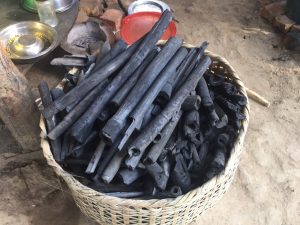
Community-made bamboo charcoal
Photo Credit: GEI

